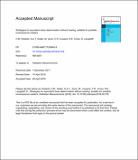Strategies for equivalent dose determination without heating, suitable for portable luminescence readers
Abstract
In recent years a number of portable instruments have been built for measuring the optically stimulated luminescence (OSL) signal from naturally occurring minerals. Some of these instruments have incorporated ionising radiation sources, giving the possibility of determining an equivalent dose (De), but little use has been made of these. One challenge has been that heating samples in this type of equipment is a major engineering challenge, yet methods for De determination use thermal pretreatments to remove charge from unstable traps, making signals arising from irradiation in nature and the laboratory comparable. This paper explores three strategies for obtaining accurate estimates of the De of samples in situations where thermal treatments are not possible: (1) deriving a correction factor based on comparing De values obtained using protocols with and without heating; (2) removing the contribution from the 110 °C TL peak and other unstable defects by component fitting the unheated OSL signal; and (3) adding a small beta dose to the sample prior to measurement of the natural luminescence signal so that the 110 °C TL peak is filled, making this measurement comparable with regeneration measurements where this peak is also populated. All three methods are promising when applied to quartz that has been physically separated from samples using standard laboratory procedures. The next step in this work will be to explore whether such methods can be applied to mixed mineral assemblages as would be encountered in the field.
Citation
Roberts , H M , Duller , G A T , Gunn , M , Cousins , C R , Cross , R E & Langstaff , D 2018 , ' Strategies for equivalent dose determination without heating, suitable for portable luminescence readers ' , Radiation Measurements , vol. In press . https://doi.org/10.1016/j.radmeas.2018.04.018
Publication
Radiation Measurements
Status
Peer reviewed
ISSN
1350-4487Type
Journal article
Description
This work was supported by the UK Space Agency CREST3 program under grant ST/P001998/1. Research in Next Generation Luminescence methods in Aberystwyth is supported by NERC grant CC003, and by HEFCW infrastructure funding for SPARCL.Collections
Items in the St Andrews Research Repository are protected by copyright, with all rights reserved, unless otherwise indicated.

